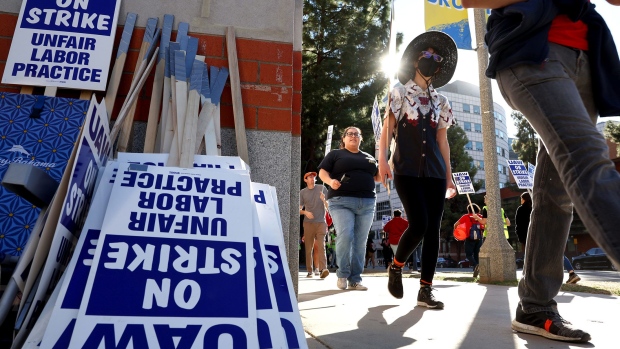Nov 18, 2022
California Strike by 48,000 Academic Workers Flexes UAW's Muscle
, Bloomberg News

(Bloomberg) -- About 48,000 academic workers across the prestigious University of California system walked off the job this week, backed by a union better known for representing assembly-line workers than teaching assistants and laboratory researchers — the United Auto Workers.
The UAW called the UC strike the largest university labor action in U.S. history. But for some like Priya Shukla, 32, a PhD candidate in environmental science and policy at the University of California at Davis, the union’s origins came as a surprise.
“I always thought the ‘A’ was ‘academic,’” said Shukla, who has been text and phone banking this week. But indeed the UAW was first organized in 1935 to advocate for auto workers in Detroit and became one of the largest and most powerful unions in the US.
That a giant of the mid-twentieth-century labor movement is now on the frontlines of college campuses speaks to the transformation underway in the US labor movement. As membership at legacy unions has dwindled over decades, organizations seeking new recruits have come up with creative pairings: within the past year, Oakland Zookeepers joined the Teamsters and the International Brotherhood of Electrical Workers began representing Colectivo Coffee employees in the Midwest.
Meanwhile, the UAW, whose membership peaked in the 1970s, has for decades found a growth market on college campuses among underpaid and overworked graduate students — or “workhorses’’ as Shukla describes them — as the population of unionized autoworkers shrinks. With the recognition of a UC Student Researchers United last year, one in four UAW members are now academic workers.
“It really was a strategic decision by some of these established unions to begin to look for other industries where they could grow,” said UC Berkeley lecturer Karen Sawislak, a union staff professional.
The UC labor stoppage comes on the heels of similar but much smaller UAW actions among graduate students at New York University and Columbia University, which ended in negotiated contracts at both institutions within the past two years — and it preceded by just two days a UAW strike by adjunct faculty at The New School in New York City. The UAW now represents more post-docs and graduate student workers than any other union.
That strength is on display across the 10 campuses of the UC system, where the strike has disrupted many of the university’s core functions, including classroom instruction, as employees across different bargaining units have aligned their negotiation schedules to walk off teaching, grading and research jobs simultaneously. It’s the culmination of years of employee frustration and small-scale labor action around pay.
Vikram Nagarajan, a 28-year-old graduate student researcher in UC Berkeley’s physics department, spends 40% of his $40,000 annual salary on rent. “In a lot of ways, it’s not enough,” he said from the picket line at UC Berkeley, where passing motorists honked in support of strikers, one of whom walked on stilts, carrying signs emblazoned with the UAW logo.
Read More: California Wants to Enroll More College Students, But There’s Nowhere to House Them
The UAW and its affiliated UC unions are demanding a minimum salary of $54,000 for graduate student workers and $70,000 a year for post-docs with annual cost-of-living raises in a state known for its spiraling housing crisis. More than 9 in 10 academic student employees are rent-burdened, a union survey found. They’re also pushing for $2,000 a month in child-care reimbursements, dependent health-care benefits, transportation assistance and greater job security. And they’ve alleged that the university has engaged in illegal bargaining practices throughout negotiations spanning more than a year, which UC officials have denied.
“Throughout the negotiations, UC has listened carefully to the union’s concerns and bargained in good faith, as illustrated by the many tentative agreements reached thus far, including on topics underlying the UAW’s allegations,” UC said in a statement.
The strike is the latest installment in a long history of UC labor organizing that started in the 1930s and gained momentum in the late 1960s, when economics TAs at the Berkeley campus sought union recognition from the UC. That organizing set the stage for a 1979 California law extending collective bargaining rights to public college and university employees in the state.
At the same time, UAW had reached its peak of nearly 1.5 million affiliated workers and was beginning to hemorrhage members. It was looking to acquire other unions, said Barry Eidlin, a sociologist at McGill University who studies labor movements. UAW found a willing partner in District 65 — an organization based in Manhattan’s Lower East Side that attracted UC students with its leftist leadership and radical, militant history, according to Eidlin. District 65 became the primary vehicle for organizing UC graduate students.
Academic workers now comprise some 100,000 of UAW’s 400,000 members. At campuses across the country, their demands are the same: job security, increased benefits and pay commensurate with their experience level and contributions to their institutions.
“People are struggling to make ends meet, people are struggling to study — at one of the best institutions in the world,” Nagarajan said. “They shouldn't have to struggle while pursuing knowledge here and passing on knowledge in the form of teaching.”
©2022 Bloomberg L.P.


